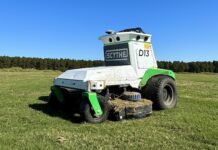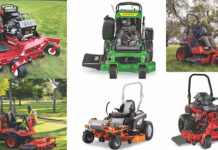Spring mowing season is here and whether you’re just starting to build a fleet or in the process of replacing aging equipment, there are more commercial mower options now than ever before. We spoke with some resources in the power equipment industry to sort through models and power sources to find out what’s the ideal piece for your needs and—most importantly—your budget.
“There is an extraordinarily diverse field of products at price point and power source today,” says Kris Kiser, president and CEO of the Outdoor Power Equipment Institute (OPEI), the equipment manufacturers’ trade association. “And it continues to evolve.”
According to Kiser, the focus is increasingly on safety and comfort for equipment operators. “Manufacturers have gotten way smarter about helping people use their machines for eight hours a day,” he said.

“Most landscape professionals have a ‘lane’ that they stay in,” says Tom Vachal, senior turf product manager for Kubota. Whether that’s wide open spaces (think: golf courses and baseball fields), tighter municipal areas, or somewhere in between —a mix of smaller yards and commercial properties—there are mowers to help optimize comfort, productivity and durability, he said.
Wide Open Spaces
For landscapers who are maintaining larger properties, like golf courses, sports fields, or college campuses, the obvious choice is a wide deck zero turn that you can just get on and go. For the larger commercial areas, “you’re going to want to optimize your speed and efficiency,” says George Reister, global product manager for Husqvarna who has over 20 years of industry experience. Because mowing large acreage usually means longer periods on the mower, he suggests their ride-on zero turn, which comes in a variety of sizes.
With an eye towards comfort, many manufacturers are designing sit on mowers with rider-friendly suspension seats and ergonomic control placement to improve the experience and cut down on break time, says Vachal. He said Kubota’s Z700 family of products offer more comfortable seating and tires that provide great flotation and traction for more sloped properties. “They allow you to get the job done and move onto the next one,” he says.
“Some people feel that sitting is actually better for bigger fields,” says Vachal, pointing out that both stand-on and zero turn mowers with 60-inch decks offer comparable speeds for users. “It’s really a preference.”
The “Swiss Army Knife” Of Mowers
Stand-on zero turn models serve a couple of purposes, says Husqvarna’s Reister, as they can be used in tighter areas and are designed for speed and maneuverability.
When it comes to maneuverability, nothing beats a smaller zero turn, says Vachal, like a 36-inch stand-on that can get into narrow and tight spaces for trimming that’s really a landscape pro’s workhorse. “Any time you can alleviate additional trimming is a time saving for the landscape pro,” he says, referring to the zero turn as the “Swiss Army knife of mowers” for their agility and ability to multitask.

Meanwhile, Husqvarna is one of the few manufacturers to offer zero turns that can be converted to walk behinds by folding up a standing platform, says Reister. Not only does that come in handy for getting around low hanging objects, like tree branches, but also convenient for mowing hillier terrain.
“Stand-ons have a clear advantage when there is overhead terrain that you have to be concerned with, particularly tree branches,” says Reister, noting that operators don’t have to stop to lower the rollover protection system to get under low-hanging vegetation.
“When you’re on a sit-on zero turn, you have to come to a complete stop, move steering arms out of the way, unbuckle from the seat, and then get up and off the machine and then repeat the process to get back on,” says Vachal. “Where a stand-on is basically pretty quick, you shift into park/neutral, step off the machine and do what you need to do then get back on and go.”
Another clear advantage of the stand-on mower is the smaller deck sizes that are just the right size for mowing homeowner associations or fitting through gates and commercial spaces with smaller grassy areas in parking lots, says Reister. The smaller footprint is also useful when a contractor is trying to get more equipment on their trailer. “That’s important when you’re trying to optimize what your crew will be taking out,” he says. “So, if you pair a ride on with a stand-on and some hand out equipment, you can have a complete trailer in a very compact way.”
Finding Right Equipment For Weather Conditions
Reister points out that since Husqvarna is a Swedish company, its equipment is designed for colder climates, with rubber deflectors that stay flexible in the coldest weather, fairly large batteries, and reliable engines to ensure dependability.
Vachal travels all over the country talking with landscape professionals about what they’re using and the products they’d like to see and for more rainy climates that means “you’ve got to make sure the switches are okay to operate.” A few years ago, Kubota adopted a protocol to ensure water doesn’t leak into its electrical system, and Husqvarna seals fuse boxes that’s akin to a motorcycle’s design.
Does Fuel Efficiency Matter?
Other factors our experts suggested taking into consideration when shopping for a new professional-grade mower are fuel efficiency and power sources.
“Cost is incredibly important to the landscaper,” says Kiser, “so engines have gotten incredibly efficient.”
Kubota fits their mowers with the Kawasaki electronic fuel injection engines (EFI), “which really helps us maintain a high level of performance of our product through varying conditions,” says Vachal. “If the grass is wet, we still have that great quality of cut.”
He points out that landscape pros don’t want to have to slow down or double cut the grass. “While fuel efficiency is important, I think performance is number one.”
Comfort For Operators
Ultimately, manufacturers’ focus on comfort not only helps improve efficiency, with less time spent requiring breaks, but it also helps with employee retention.
“We travel all across the country and landscapers are telling us it’s harder and harder to find labor,” says Vachal, explaining that many pros are buying models with good cushioning and suspension seating with high backs to reduce employee fatigue. Research has led to stand-on products are forward leaning with bolstered pads cushioning users’ upper thighs and ergonomically placed controls for increased comfort.
Landscape pros tell Vachal that comfort and productivity are the keys to help making them profitable. “Comfort helps with employee retention and productivity allows them to get the job done quickly and ahead of schedule.”
Robotic Mowers Standard Published
By Turf Staff
Manufacturers and start-ups are now able to design robotic, battery-powered and electrical lawn mowers to the industry standard—with the January 2020 publication of the first-ever standard for this equipment by the American National Standards Institute (ANSI) and Outdoor Power Equipment Institute (OPEI).
“Artificial intelligence, connected technologies, and other innovations are changing all industries—including the outdoor power equipment industry,” said Kris Kiser, President and CEO of OPEI. “Consumers and commercial users are getting more comfortable with the idea of using new tech, such as robotic mowers. Consumers today still want beautiful and useful yards they can enjoy and spend time in, but they also want to have smart yard maintenance that can be easily managed with an app.”
Kiser added, “What is available now for homeowners and commercial users should expand dramatically over the next few years, thanks to the publication of the standard. We expect to see more competition in this product category as manufacturers design equipment to meet the industry standard. It’s an exciting time to be in the outdoor power equipment industry.”
The ANSI/OPEI robotic mower standard is ANSI/OPEI 60335-2-107-2020 (Standard) for Outdoor Power Equipment—Household and similar electrical appliances— Safety— Part 2-107: Particular requirements for robotic battery powered electrical lawnmowers (national adoption with modifications of IEC 60335-2-107).
The standard was approved on September 5, 2019 and is sold through the ANSI website (webstore.ansi.org).
The standard was developed through a public input process that brings together consumers, manufacturers and commercial equipment users. OPEI is a recognized Standards Development Organization for ANSI and active internationally through the International Organization for Standardization (ISO) and the International Electrotechnical Commission (IEC) in the development of safety and performance standards.
ANSI is the primary organization for fostering the development of technology standards in the United States. ANSI works with industry groups and is the U.S. member of the International Organization for Standardization (ISO) and the International Electrotechnical Commission (IEC).
What’s On The Horizon?
Kiser says he’s seeing a movement towards more robotics, which can help solve the industry-wide labor shortage, as well as a trend in interconnectivity where machines communicate issues they’re having directly to its user through an app. (See sidebar about the newly published ANSI/OPEI robotic mower standard.)

Kiser’s advice for landscape pros on the hunt for a new mower? “Evaluate what are my needs, how much work do I have to do, how big a unit do I want, what’s my budget, what’s the power source I want?”
He adds, “The great thing about this industry is there’s a product for everyone’s needs.”
Byrnes is a freelance journalist. You can read more of her work at amybyrnes.com.
Do you have a comment? Share your thoughts in the Comments section below or send an e-mail to the Editor at acosgrove@groupc.com.











![[VIDEO] Dickies®: Discover Workwear That’s Anything But Uniform](https://turfmagazine.com/wp-content/uploads/2023/06/1647663814-4b1a2a7742790a9b1e97a3b963477850192e1d6a9dfba9b07214a77bae25d6e3-d-218x150.jpg)



























![[VIDEO] Dickies®: Discover Workwear That’s Anything But Uniform](https://turfmagazine.com/wp-content/uploads/2023/06/1647663814-4b1a2a7742790a9b1e97a3b963477850192e1d6a9dfba9b07214a77bae25d6e3-d-324x160.jpg)